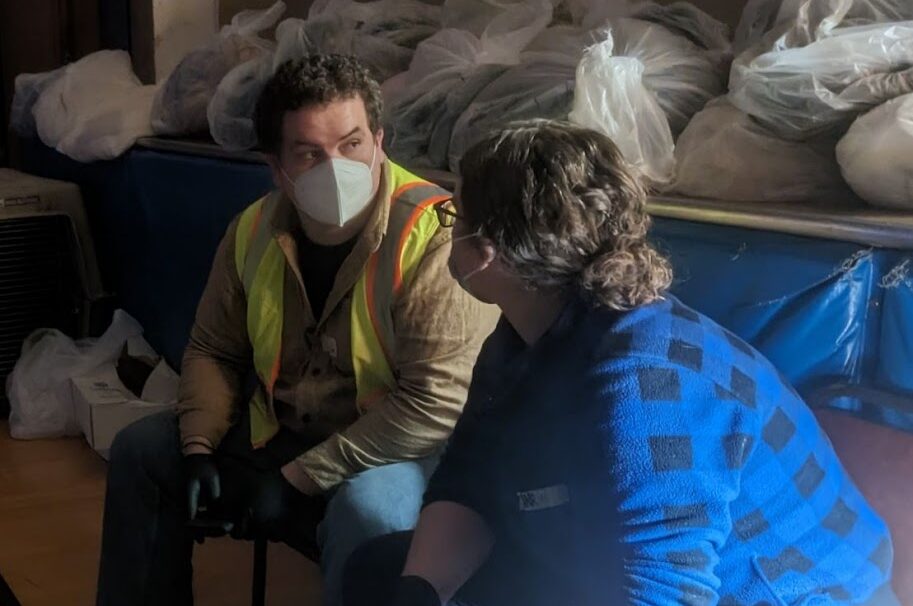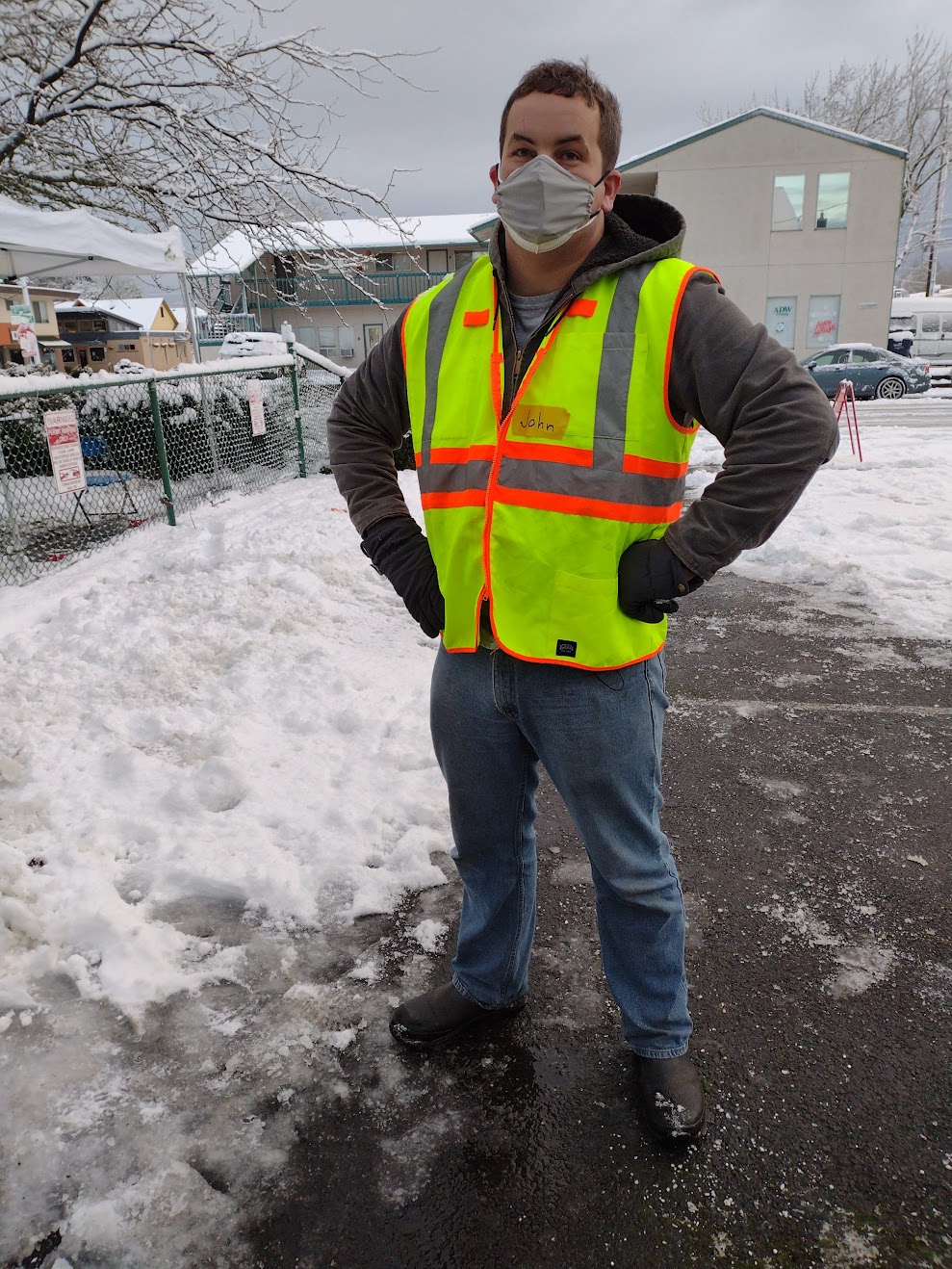On January 12, 2024, a destructive ice storm brought extensive damage and disruption to the Willamette Valley. During that time, the St. Vincent de Paul-administered Egan Warming Centers program activated in response to low temperatures and freezing rains. Three days into the activation, it became clear that this would not be a typical Egan response. Community members began arriving at warming shelters after being displaced by the weather, which had downed many trees and caused widespread power outages, and Egan volunteers were soon pushed to their limits. Worsening road conditions made travel all but impossible for many and volunteers were left without consistent relief. Many of these volunteers ultimately worked with little rest for the entirety of the four-day weather event.

John E. Helmer speaks with another volunteer at the Springfield Egan site.
The following is an interview with one of those volunteers. John E. Helmer volunteers along with his sister Charlotte at the Egan warming site in Springfield, located in the Memorial Building. He recently sat down to share his story of volunteering during a natural disaster, and why he plans to continue showing up for Egan Warming Centers in the future.
JOHN E. HELMER INTERVIEW
Interviewer: How long have you been volunteering with Egan Warming Centers?
John: I believe this is my seventh season of activations.
Interviewer: What made you want to get involved as a volunteer?
John: I heard about it from people I know including my father, who had got glued into it as something worth doing. It’s one of those things you hear about it, and it sounds like a good thing to do. Then you show up and you do it and it becomes an imperative. It’s obvious that this must be done in the winter. You can’t get away from the need once you know about it.
Interviewer: Sure, that first activation exposure kind of showed the importance of the program?
John: Yeah. Once I spent a couple more seasons there, I got to know people there so I had specific names and faces and there were people that I would recognize on the streets during other parts of the year, and I knew they would be out in the cold once winter came back around. So that just became part of my plan of what I would do in the winter.
Interviewer: What year was that first activation for you?
John: 2017 and 2018 season.
Interviewer: So, obviously we just came out of a pretty nasty winter weather emergency where a lot was asked of Egan and a lot more was asked of Egan volunteers than usual. Can you talk about the atmosphere going into that first volunteer shift during this event?
John: Sure, so we started out with two relatively normal days with Saturday and then Sunday nights of activations and we just knew it was going to get bad. Then, coming in on Monday I was mentally preparing myself so that I would not know when I was going to leave. I’d signed up for a four-hour shift, but I might very well be there for 24 hours straight as far as I could tell. There was no obvious sort of end point to when I would no longer be there. Especially because I was going in and I live outside town. Ice came in and the power went out, so I ended up sleeping in town and just walking back to the Egan site in the morning after I’d gotten a little bit of sleep. Then Tuesday morning arrived, and I was already thinking I was going to need to be there for many hours. I ended up staying there for 17 hours on Tuesday which was a lot, but you could sort of see that coming in terms of what was available. It is hard for Egan to mobilize people to come out during the best of times, let alone in the middle of an ice storm on the fourth day of an activation.
Interviewer: Right, so a lot of Egan volunteers who did show up were asked to stay late?
John: They weren’t even asked really. It was just necessary. There weren’t any replacements. They didn’t ask anyone to go beyond what they could do. The emphasis was on staying safe. “Do what you can do and go home when you can’t do anymore” but we couldn’t just leave people, so it was just what was necessary.
Interviewer: Was there a decision made amongst volunteers that you all were just going to stay?
John: Well, it certainly was something we had to come to terms with. I kind of felt it coming since I’d arrived that morning. We needed the authority to stay open because there were none of the usual places for people to go during the day (because of the storm).
Interviewer: I know that we really appreciate the work that you (the volunteers) did during the incident and the selflessness you displayed. Getting back to what constitutes a normal Egan experience; what challenges do you think new volunteers face and how can they overcome those challenges?
John: Well, what I didn’t really expect was how much community there is with Egan. It’s one of the things that keeps bringing me back. I have a community with guests and volunteers. When I show up in the morning, I know every single volunteer that’s there. For new volunteers, challenges can depend on their skillset. If someone has experience working in customer service, then they’ll be fine as far as I’m concerned. They’ve been trained and they know what the principles of Egan are. The volunteers who seem to struggle are the ones who don’t respect that as much. They think they have more to do or they’re fundamentally not comfortable around homeless people which is a decently large number of people, but even then, if they just stick with it and they find a job that allows them to do something straightforward where they won’t need to talk to people. My first couple of years of volunteering I was working outside which was kind of nice because that’s just what was comfortable for me, but it also meant that I didn’t get to know people very well. Eventually, I started transferring inside more and more. I just didn’t feel very comfortable talking to people but transferring to inside helped me build those connections and made me want to keep coming back.
Interviewer: When you refer to inside and outside what do you mean?
John: There’s outside work that is focused on safety for guests arriving and leaving. De-icing, shoveling, cleanup, etc. Inside work is where you’re going to be more face-to-face with people and interacting.
Interviewer: How can we help set volunteers up for success?
John: Emphasizing how flexible the roles are and how you can sort of transfer into more face-to-face contact or away from that, depending on how comfortable you are. I mean, we have volunteers who are extremely valuable contributors who show up at the end to do the cleanup or for the setup, or they are down in the kitchen doing the food prep. There are a lot of different roles that are useful.
Interviewer: Yeah, I think helping people to understand there are many ways to help out will overcome that initial barrier to signing up.
John: It also really helps to bring a buddy along. So oftentimes couples will come in together, or somebody who is an existing volunteer will bring along a friend.
Interviewer: What advice would you give someone who is thinking of volunteering? Someone who is on the fence?
John: Do it. Whatever hangup someone has there’s likely a solution. Either you get there and it’s not the problem you thought it was, or you’re not as comfortable doing the jobs that Egan wants, there is a way to work around that. There’s a way to help without putting you in

John E. Helmer, Egan Warming Centers volunteer.
a situation that feels unsafe or beyond you.
Interviewer: Yeah. Just take the plunge. Things are always worse in our minds than they are in reality.
John: Yeah, and no one is alone. This is a team effort. You are always in sight of somebody else. You’ll always have someone to lean on for experience with situations you’re not familiar with.
Interviewer: Do you have a particular Egan memory that you’re fond of?
John: It’s not my memory but my father just had an experience with someone he met on the street during this last activation and didn’t recognize who he was. Turns out he was a pillar of the community and was a guest back at Egan in 2017. He’d gotten clean and off the street and was now helping people himself. My father had bought a pair of shoes for him when he was a guest. Anytime I see somebody who is doing better, those are the memories I cherish the most. Anytime a guest thanks me for being there that’s valuable to me, especially during this last activation with all the storm refugees. Like couples in their 80s who had a tree fall through their house, and a guy who needed power for a CPAP machine.
Interviewer: We talked about it a little bit already, but what keeps you coming back to Egan every year?
John: Gosh, there’s two answers to that. One answer is necessity. I must or else I don’t know what’s going to happen to those people. Another strong reason is the positive aspects of community. We have a community of volunteers and a community of guests, and those things are intertwined. We also have people who, if they weren’t guests, would be volunteers. They are extremely helpful.
Interviewer: Thanks, John, for coming in. Before we end are there any last words you’d like to say about what Egan means to you?
John: Egan means helping my neighbors. Showing up for the community. Egan is a clear enactment of my own values. There’s no delayed gratification. You can see the direct impact you’re making in someone’s life.


